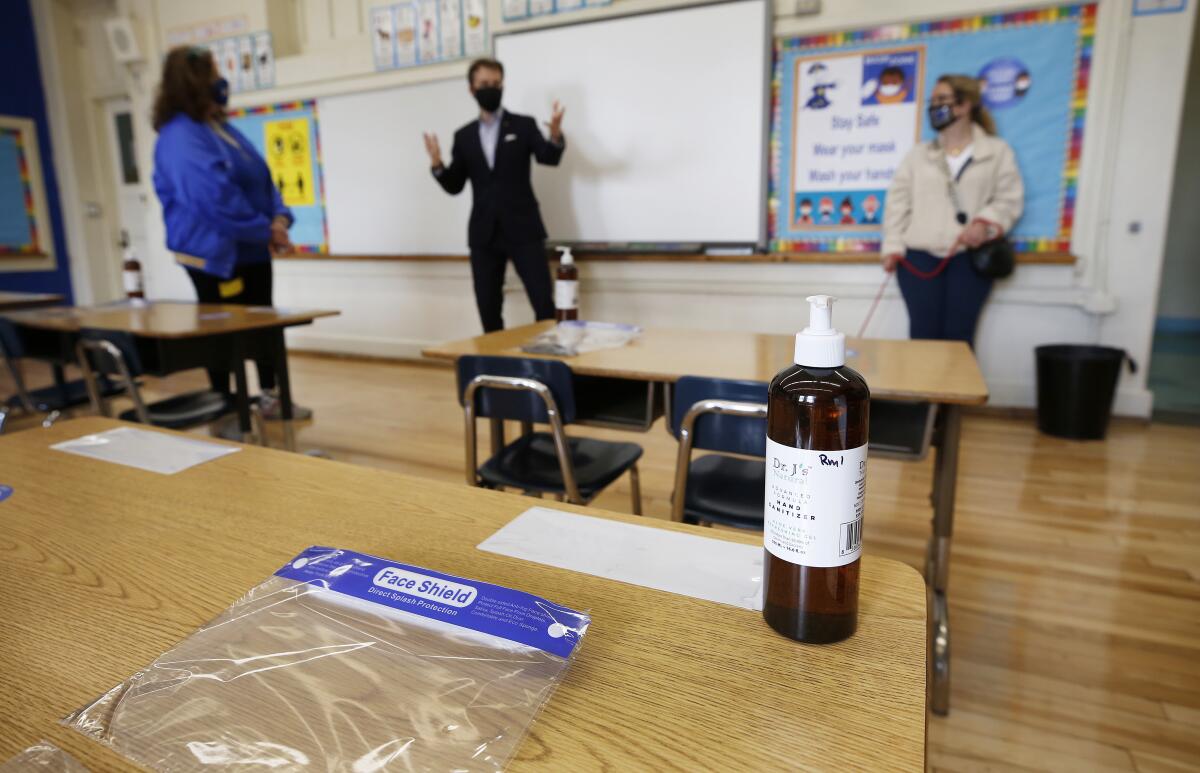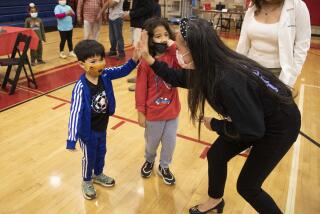California adopts 3-foot-spacing rule for classrooms, changing reopening equation

Students in California are now allowed to sit three feet apart in classrooms — instead of four or six feet — in guidelines state officials issued over the weekend, a major change in policy that will exert pressure on local officials to consider a faster and more complete reopening of campuses that have been closed for over a year in response to the COVID-19 pandemic.
Local education leaders, however, will have the final say — and Los Angeles schools Supt. Austin Beutner said Sunday that the L.A. Unified School District would keep the six-foot rule.
Still, the ground has shifted rapidly since the federal Centers for Disease Control and Prevention on Friday announced its endorsement of a three-foot rule for elementary schools. The agency also OKd three-foot desk spacing on campuses with older students, but there are substantial caveats, including the rate of coronavirus cases in the community.
It took one day for the state of California to follow suit. L.A. County health officials have yet to formally announce their own rules — which may be more strict than the state’s — but Dr. Paul Simon, chief science officer for the county Public Health Department, said Friday that he was “fairly confident that we will incorporate that CDC guidance into our own guidance for schools.”
The three-foot standard is a key metric because it could allow school districts to avoid staggered, hybrid schedules and return students to campus full time in something very much like a normal school day.
The wider spacing between desks had the effect of preventing students from returning all at once in a standard-sized California classroom.
Other safety protocols would not change. Most notably, students must still wear masks at all times while in class.
How soon the new state standard will come into use seems likely to vary from place to place. Some schools and districts have chafed at restrictive measures and are almost certain to embrace the revised rules.
Las Virgenes Unified, which straddles the border between L.A. and Ventura counties, is scheduled to begin classes for all secondary students Monday, under a hybrid plan that will keep them home in distance learning about half the time.
“We’re very interested in this new guidance,” Supt. Dan Stepenosky said. It provides “a wonderful opportunity to have our secondary students on-campus for more in-person instruction.”
He added that he intends to discuss the revised rules with other district leaders and with the unions that represent employees.
Many school systems have approved agreements with their teachers unions that stipulate a six-foot desk separation. These districts include Los Angeles Unified, the nation’s second-largest school system, which has no immediate plans to change its reopening protocols, Beutner said.
“Our challenge is convincing families that schools are safe, not finding ways to stuff more kids into classrooms,” Beutner said.
Early survey results released last week indicated that about half of students would be returning when campuses begin to reopen in mid-April. Families were most reluctant in higher-poverty communities, which have had the highest rates of COVID-19 illness and death.
That effort included an online town hall Sunday. During the meeting, Beutner assured those listening on more than 625 computer devices that the district has “the highest standards of COVID safety in the nation.”
He said this includes upgrades to air filtration systems in every classroom that will run 24 hours a day, double the number of school custodial staffers and weekly coronavirus testing for students, staff and their families. He said the district is also working to make vaccines available to families in school communities.
United Teachers Los Angeles said Sunday that its return-to-campus agreement was approved by 89% of members who voted.
Union leaders said the revised CDC guidelines would potentially endanger students, their families and school staff by making virus transmission more likely.
“The continual erosion of safety standards from the state has made an unprecedented situation for educators, students and parents even more difficult,” union President Cecily Myart-Cruz said. “Our school communities need clear guidance, grounded in science and rooted in equity, so that we can reopen schools safely while minimizing risk to our hardest-hit communities.”
The statewide California Teachers Assn. spoke in similar terms.
“Another shift in guidelines as a way to sprint back to classrooms sends another confusing message to students, parents and families,” President E. Toby Boyd said in a statement. “Opening and keeping our schools open for in-person instruction is going to take all of us, a community and statewide effort as national experts warn of a fourth surge and the concerning variants.”
Teachers and other employees in L.A. Unified will not be expected to return to campus until they have an opportunity to be vaccinated and to achieve maximum immunity, which is why in-person classes are delayed until at least mid-April.
Karla Garcia, who has a fourth-grader enrolled in Palms Elementary on the Westside, called the new guidelines potentially wonderful news but said the district should move forward with the plan already worked out.
“For right now, so that teachers and parents feel confident, why don’t we just stick with the tentative agreement?” said Garcia, a parent leader with the local advocacy group Reclaim Our Schools LA, which works closely with the union. “We’re almost out of this.”
Garcia will keep her son home for now but added, “I think six feet instead of three feet will give families a little more confidence.”
Other parents hoped the guidelines would lead to immediate change.
“This will allow middle and high schools to service more students, something desperately needed,” said Jill Pintens, who has two students at St. Anastasia Catholic School in Westchester and two children at El Segundo High School. “Safety is not subjective, and L.A. County cannot pick and choose which CDC guidelines they prefer. Parents who are not comfortable with the reduced spacing still have the option to keep their students at home for full distance learning.”
“I would send them back full time today,” said Kelli Haas, who has fifth- and seventh-graders in the Santa Monica-Malibu Unified School District.
The new desk-spacing standard is based on recent research evaluated by state and federal health authorities. It is based substantially on the experience in Massachusetts, where school officials were allowed to choose a three- or six-foot separation. Researchers concluded there was no material difference in the risk of spread between the two formats — provided that other safety measures were properly followed.
National teachers union leaders on Friday urged caution in applying these findings to all situations.
“Maintaining a minimum of 3 feet between student chairs is strongly recommended,” the revised guidelines state. “A range of physical distancing recommendations have been made nationally and internationally, from 3 feet to 6 feet.”
But if there are doubts about whether students will keep their masks on, “consider more robust physical distancing practices.” And the guidelines emphasize layers of mitigation, such as maintaining stable groups, improving ventilation and continuing to maintain six feet of distancing “as much as possible” when students or staffers are not masked, including when they are eating or drinking.
More to Read
Sign up for Essential California
The most important California stories and recommendations in your inbox every morning.
You may occasionally receive promotional content from the Los Angeles Times.











